Deck Materials Are Offered in a Wide Array of Options. What's Right for You?
Which deck materials are right for your deck? Which material is best? Which one last longest? Which one requires the least maintenance? Which one costs the most? Or the least? If you choose wrongly, you may have just spent a lot of money on a product you aren't happy with. And one you will likely be stuck with for quite a while.
The answers to these questions and more are found here. There is no single answer to some questions about deck materials. Your situation has considerations that others may not have, so your needs will be different. Let's look at the options so you can make an informed and confident decision. A decision that you will be happy about for years.
The primary materials used for decks are; wood, composite lumber, plastic and aluminum. We'll look at them individually as you decide what material is best for your deck and your wallet.
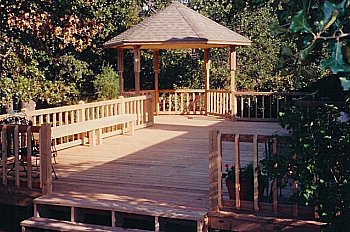
Wood
Wood is by far the most common option used for deck materials. Somewhere around 85 percent of single family homes have some sort of deck. A very high percentage of those are made of wood, mostly treated pine. There are good reasons for the popularity of treated lumber. Yellow pine is strong. If you want to impress your friends you can describe it as dimensionally stable. The rest of us just say strong. It is inexpensive (relatively speaking) and readily available, pretty much everywhere. Treated lumber looks good, especially after it has been stained.When it weathers, it can be refinished easily and look as good or better than new. Treated pine is easy to cut, nail, screw, and work with in general. On the down side, it doesn't last as long as most of the other products. With proper care, you should get 15 to 18 years of good service from a treated lumber deck. Yes, you will need to clean, sand and refinishit every other year or so. And there are always the splinters, cracks, warps, and general wearing out over time. It's always best to look at cost issues over time, rather than just the initial cost. Estimates vary, but when the cost of maintenance is factored in, the cost of treated pine usually catches up with more expensive woods in 5 to 8 years. Of course, if you need to keep the initial cost low, the cost over 8 years isn't what is important at that time. Let's look at some of the other available wood species.
RedwoodRedwood is an excellent choice for deck material. But you should be very aware of the different grades of redwood. Essentially, the grade is determined by which part of the tree the wood came from, among other factors. The best, and most expensive grade is heartwood, which comes from the heart (or center) of the tree. "Construction heart" and "Select heart" are the best to use for decks. Heartwood can last over 30 years in favorable climates. Even in harsh climates it will easily last 20 years. Any other grade should be used only if pressure treated first. This and other harder "soft woods" should be drilled before nailing at the ends of the board to avoid splitting. Redwood has a brownish red color that ages beautifully. Maintenance is still required, but much less often than pressure treated pine. Redwood costs about three times the cost of pressure treated pine. Labor costs should be comparable.
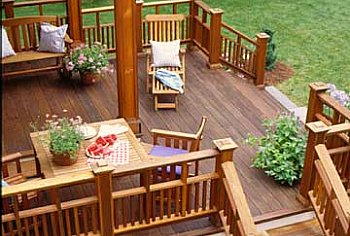
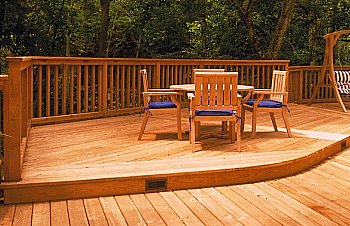
Cedar
Cedar is another fine choice for deck material. Again, grade is important. "Custom clear" or "Architect clear" are the best grades for your deck. Why, you ask, does it matter which part of the tree the lumber comes from? The center, or heart, of the tree contains more of the resins that make these species less susceptible to the damaging effects of the weather. The growth rings are closer together, giving the wood a tighter grain - so less tendancy to warp. This wood is also more resistant to insects and less likely to rot. End of botany lesson. There are several varieties of cedar, with colors ranging from reds to yellows. The lighter colored species stain beautifully. Like redwood, the ends of the boards should be pre-drilled. Most cedars will easily last 20 years.
Mahogany
Mahogany is ocassionally used for decking materials. You need to be careful if you chooses mahogany - be sure the wood comes from South or Central America, Mexico, or the West Indies. Usually called American mahogany, this species has great qualities for deck building. It is highly resistant to water and insects and has a deep red color that makes a stunning deck. Avoid the Philippine mahogany varieties as they are not nearly as suitable. The same general rules apply with mahogany as with the other high end woods.
IpeIpe (pronounced ee-pay) is a great wood for deck building. It has some characteristics that are unique among these high end deck materials. And its name is the most fun to say. Really, say "Ipe" quickly five times without giggling. Okay, maybe its just me. Anyway, the wood is extremely durable and is almost impossible to make warp, cup, twist OR splinter. There is no need to seal Ipe, except on the ends of the boards where it is cut. It will weather to a silvery gray color, but will not splinter and will remain smooth. Ipe is also known as ironwood and by the trade name of Pau Lope. It is a very slow growing tree, hence the growth rings are close together and it is extremely dense. That density produces its good qualities, but it also makes it very hard and very heavy. So it is hard to cut and hard to work with in general. Expect your labor costs to be high, as well as your material costs. If Ipe fits in your budget, you will have a beautiful, very low maintenance deck for 30 years or more.
Any of these woods, including the lowly pressure treated pine, can be used to build a beautiful, long lasting deck that will serve you well for years. The differences are in the life of the wood, the maintenence requirements, how it ages and weathers, and the appearance characteristics of the particular species. Cost is reflected in how well the particular decking materials respond to each of those factors. Weigh the benefits aainst your budget, pick one, and start building! Of course, there are other options as well...
Composite Deck MaterialsComposite decking has been the subject of some contoversy over the years. I really believe the problem was that it was over-hyped when it was introduced. Many people believed that it was the end of all problems associated with deck materials. They thought is was maintenance free and it would last forever. It is not and it will not. Composite lumber is made of a blend of plastic and wood. If there are exposed pieces of wood, they will be subject to the same properties of deterioration as all other wood. The pieces of wood that are completely encapsulated within the plastic will not be exposed to the elements, so they should not deteriorate. Composite deck materials are not all the same, so use a quality product from a reputable source if you choose this option. Avoid the "cheapos', or you'll likely regret it. Composite decking material is "low maintenance"; it is NOT "no maintenance". I'm pretty sure that violates some grammer rule, but you know what I mean. The color will fade over time, and the material can collect stains. Composite material can be scratched fairly easily. In direct sunlight, it can get very hot! If you walk on it barefoot, it will not take you long to get where you wanted to be. However, you will not have any splinters when you get there, because there aren't any. Composite material can be prone to mold and mildew, although improvements in the product have made this less of a problem. It is not as structurally strong as wood so it has to be well supported to avoid bounciness. Typically, treated yellow pine is used for the support structure and composite components are used for the decking and the rails. Thin material is available for wrapping the outer band to give a more uniform appearance. The railing components are quite expensive, so PVC railing is often substituted. When composite decking materials deteriorate, they can't be sanded and refinished, like real wood.
If this sounds like I'm anti-composite, I'm not. It is actually a good product and many, many people have used it with great results and are completely happy with it. It's just that the product was originally built up to be something it is not. The product is durable and while it will weather, it does not disintegrate. Many of the negatives I pointed out earlier also apply to real wood. Composite deck materials don't warp or rot, and never needs sanding or sealing. The boards are all consistent in size and appearance. There are no splits, cracks, or knotholes. Use it if it meets your needs, just understand that it does not last forever.
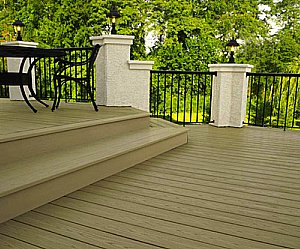
Plastic Deck Materials
Plastic deck materials are similar to composite, but there is no wood - they are pure plastic. These materials typically cost about 15% more than composite while keeping many of the same characteristics - but not all. Like composite, they offer a very consistent, uniform appearance. They are completely impervious to insects and to rot. Most plastic deck materials are installed with a system that hides the screws, so there is a very neat appearance, The panels interlock so there is no water dripping through to the area underneath. This is especially nice if you have a patio or other usable space under you deck. Plastic decking requires little maintenance, similar to composite materials. It offers little in the way of structural strength, so proper support is critical. Unlike composite decking, plastic deck materials stay relatively cool, even in direct sunlight. Some customers complain of brittleness in very cold climates or when exposed to heavy UV rays for extended periods, but that is usually not a severe problem. In very hot climates, the plastic will expand and contract as it heats and cools, although again, this isn't normally excessive. From a practical standpoint, plastic decking makes a lot of sense, although it is expensive. From an aesthetic viewpoint, it is so consistent it lacks the "character" of other products. It almost looks too good. Of course, that is just my opinion, you may like that look. It has its advantages, so consider it for your project.
Aluminum Deck Materials
Aluminum is the last material we will consider here. I saved the most expensive for last. Just remember to consider that expense over time, not just at the initial buying time. Aluminum decking will outlast anything else mentioned, so if you buy it when you are 3 years old and live to be 96, it may actually be the cheapest! Really, it won't take that long to average out to be a good deal, but will you be in that house that long? It may help on resale, so you still might come out ahead. Aluminum is very low maintenance, and is easy to clean. It looks good, although it can be dented. Aluminum is lighter than the other products, but stronger. Like plastic, it stays cool in the sun, so there's no need to run across it like your on hot sand. Also like plastic, it has a very clean, almost sterile look. It lacks the homey character many of us like in good deck materials. It is probably the most practical, most expensive, but least warm of the deck materials listed. It would be an excellent choice for a commercial application, or maybe for a rental home at the beach.
In general, there are four factors to consider when making a decision about what to use for your deck materials:
1. The product itself. Does it fit in your budget? Is it readily available in your area? Will it look right with your house?
2. Installation. If you choose a specialty product, you may need a specialty installer. Does the cost of installation push the cost up more than you expected? Can you get references? Your local materials supplier can often help with installers.
3. Maintenance. How often will your deck need maintenance. How extensive is the process. Are you willing and able to do it yourself? How much will it cost to hire someone to do it for you?
4. Longevity. How many years will it be before the deck needs to be replaced. Will you still be in the house? How might that affect resale?
Plug all these factors into you thought process. Remember to figure the cost over time, not just initially. A nice, well maintained, well designed, and well built deck will not only give you and your family years of enjoyment, it can add significantly to the value of your home. Make you decision, and get your project rolling!
Go to Staining
Simply The Best. Camino Construction Servicesis the best source for decks, porches, gazebos, whatever your outdoor construction needs may be. In central North Carolina, they are the recommended builder of Backyard Design Ideas. Give them a call - 980-722-7370.
All of the information and ideas provided here are free to you. If you would like to help us keep it free, consider a donation. Any amount is greatly appreciated, although donations over one million dollars will get you a personalized note of thanks! Anyway, if you want to help, just click the button below. Thanks!
Related Pages
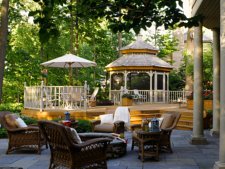
Deck Design Ideas
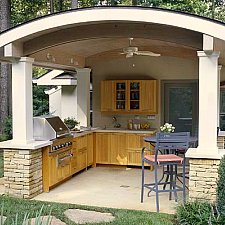
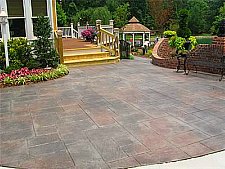
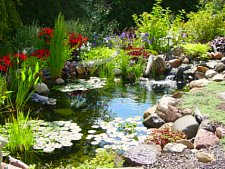
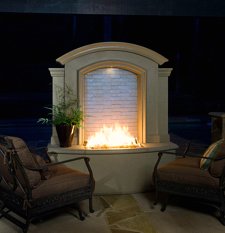
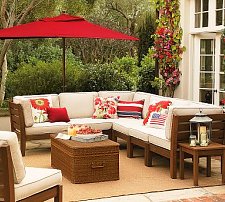
Outdoor Furniture About This Site What is SBI?
Most Viewed Pages
Backyard Pond Ideas Outdoor Fireplaces BBQ Islands Teak Deck Furniture Deck Railing Options Water Gardens Low Voltage Lighting Backyard Waterfalls Grills - Which Is Best? Deck Materials - What Is Best? Outdoor Kitchen Cabinets How To Stain Your Deck







New! Comments
Have your say about what you just read! Leave me a comment in the box below.